Jet Lag. If you have experienced it yourself, it may give you pause about subjecting your children to it. If you’re considering a first long flight for your entire family, the unknown can be concerning. Let me reassure you that it’s worth the jet lag to see new places or be there for a special event somewhere else in the world.
Don’t let other people’s stories about bag jet lag stop you from planning ahead your next adventure and managing your family’s jet lag as best as possible. There are several factors to consider including the length of time available for your trip, the flexibility and makeup of your family, making the most of the advice of more traveled parents, and more listed below.
I will provide two example cases for longer family international travel and how to apply the advice listed. I’ll list how many we stayed in each city before moving on in the trip and how many days are lost in the travel due to traveling across time zones.

The first example is traveling West across seven time zones with two school age kids and one preschooler.

The second example is traveling East across twelve time zones with three school age kids.
Here are my 18 tips for improving your jet lag experience:
1. Understand what jet lag actually is
 What is Jet Lag? According to Mayo Clinic, “jet lag is a temporary sleep problem that can affect anyone who quickly travels across multiple time zones.” Most of us associate difficult in assimilating to the new time zone, drowsiness and lack of alertness with jet lag. It can also include gastrointestinal symptoms. Mayo Clinic explains that crossing more than two time zones is when we are likely to have possible systems which increase with the distance traveled.
What is Jet Lag? According to Mayo Clinic, “jet lag is a temporary sleep problem that can affect anyone who quickly travels across multiple time zones.” Most of us associate difficult in assimilating to the new time zone, drowsiness and lack of alertness with jet lag. It can also include gastrointestinal symptoms. Mayo Clinic explains that crossing more than two time zones is when we are likely to have possible systems which increase with the distance traveled.
Whether you are someone who needs a lot or a little sleep to function, we are all following a circadian rhythm to which our body is accustomed. When we mess with our sleep-wake schedule, our body has to try to reconcile somehow. The degree to which and how quickly this is possible is relative to the distance traveled and what direction you’re traveling.
2. Decide how much you can handle – East To West vs. West To East
It’s pretty universally accepted that traveling Eastward (i.e. US to Asia) is much more challenging than traveling Westward (i.e. US to Europe). Shortening our days and trying to have a semblance of the circadian rhythm our body knows is far harder than lengthening the day. Since two time zones or more can equate some jet lag and larger trips (like traveling to Asia) can completely flip our day, we have to consider what will work for your family. I’m personally a believer that anyone can overcome jetlag at any age, but for some, it may take more time. You will want to consider the flexibility of your family, your expectations of your trip and available time to work in your itinerary.
3. Booking Smart
As always, I recommend using Google Flights to get a good understanding of the routes available to your desired destination. For most places, this will vary by the day of the week. We want to get closer to the time zone of the destination as soon as possible, so considering the time difference and where the sleeping will fit into the schedule is key.
For our example #1 from Chicago to Rome (or any European destination), I suggest leaving in the evening and taking an overnight flight. If you need to take a connecting flight, make sure the first flight is overnight versus connecting in the middle of the night. A direct flight leaving at near bedtime will have you arriving mid-day in the time zone of your destination. It will feel like morning to you, but a morning after you haven’t slept your best and have already managed the stress of travel. By bedtime at your destination, I would expect everyone to be ready for sleep

For our example #2 from Chicago to Bangkok (or most Asian destinations), your options for choosing your timing might be more limited and more likely will require a connecting flight depending on from where you are departing. As you can see from my example, you are actually spending two calendar days traveling. You will get these back on the return of course, but it is still a strange concept to grasp. Considering the time at the final destinations is helpful from the start. Based on the final destination, it’s most important to get sleep on the second plane coming into Bangkok versus sleeping a full night going to Tokyo since it will actually be the early morning upon arrival in Bangkok. Depending on the age of your children, your ability to control when they sleep in a moving vehicle may be more or less feasible. Older kids will be happy to watch movies and eat the late night meals. The push on the first day after arrival will help set the tone for the next several days.
4. Use a Jet Lag Calculator
 To decide how much adjustment is required to go from your current schedule to the schedule at your destination, try out a jet lag calculator. For school age kids to adults, most adjustment to schedule will take 3-4 days at most, but younger children won’t have the ability to understand the schedule changes or have the motivation to be flexible. One method to improve the results for your entire family is to begin altering your schedule before you travel. Use one of these calculators and lay any naps your child is currently taking into the adjusted schedule. You may even want to bump your meals up or down to meet the adjusting schedule to the extent possible.
To decide how much adjustment is required to go from your current schedule to the schedule at your destination, try out a jet lag calculator. For school age kids to adults, most adjustment to schedule will take 3-4 days at most, but younger children won’t have the ability to understand the schedule changes or have the motivation to be flexible. One method to improve the results for your entire family is to begin altering your schedule before you travel. Use one of these calculators and lay any naps your child is currently taking into the adjusted schedule. You may even want to bump your meals up or down to meet the adjusting schedule to the extent possible.
This calculator will provide you with a schedule for the week before and after your arrival for dark, light, and sleep times. I like this one because you can put in your expect locations and times for your flights.
British Airways Light/Dark Recommendation Calculator
This calculator focuses on the light and dark you should try to expose yourself to in order to combat jet lag.
Here are ways to prepare for jet lag in my two examples. Notice the difference between traveling East seven time zones versus West for twelve time zones. Notice I chose to start my preparation three days in advance of leaving. A longer, gentler preparation would make the transition easier, but this is more realistic to the level of effort I would make:
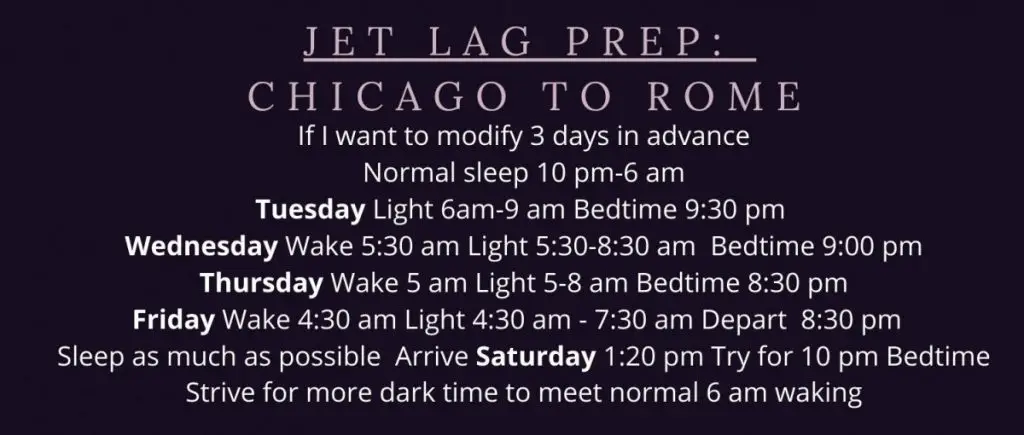
To me, this approach to preparing for Rome is feasible for a family to accomplish. My kids go to bed 1.5-2 hours before we do so I would just adjust this upward for them. However, as I’ve stated, going West and extending your day isn’t as hard for most of us. I would probably put this effort with a baby or toddler knowing that it was just a best effort. I also know that I could likely follow this schedule without greatly impacting the rest of my week – work, activities, etc.
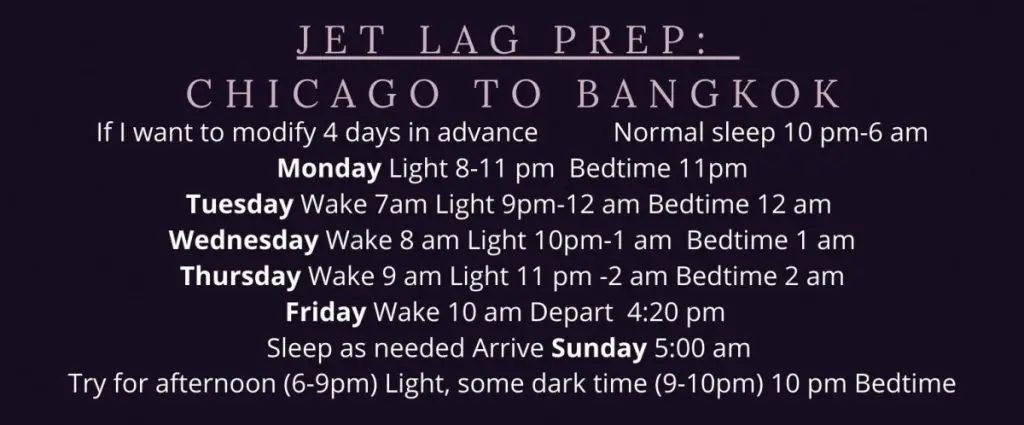
This example is much more extreme. This preparation implies that you have a very flexible life in order to put the preparation in. Again, perhaps this would be possible if you were staying home with a baby or toddler. To be perfectly honest, my approach with my children at the time of our trip to Bangkok (ages 11, 9, and 6) was to simply go to bed earlier and encourage them to sleep in. Sometimes they do and sometimes they lie awake until the time I’ve designated they can get up.
5. Sleeping on the Plane
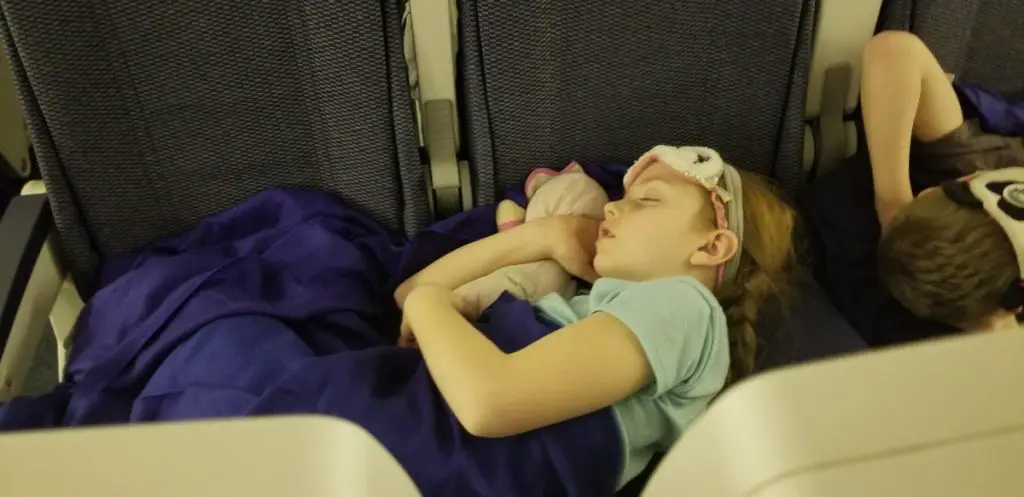 When you are trying to sleep at times that feel unnatural to your body, you will have to help yourself along. The goal on long haul flights is to sleep when it’s night at your destination and whatever amount you need stave you over until that time. In both of the itineraries I have suggested, you will be on planes that are flying in the dark which is a great help as the lights will be lowered at some point and even if a window is open, there won’t be light streaming at you. However, with screens at every seat and noises all around, it’s best to be prepared.
When you are trying to sleep at times that feel unnatural to your body, you will have to help yourself along. The goal on long haul flights is to sleep when it’s night at your destination and whatever amount you need stave you over until that time. In both of the itineraries I have suggested, you will be on planes that are flying in the dark which is a great help as the lights will be lowered at some point and even if a window is open, there won’t be light streaming at you. However, with screens at every seat and noises all around, it’s best to be prepared.
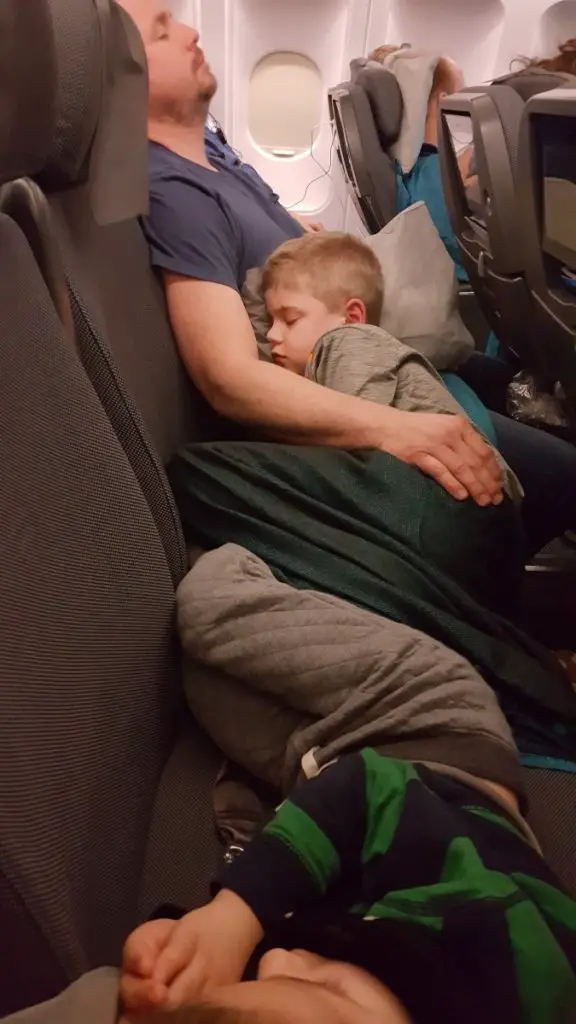 For kids, I recommend bringing head phones that cover their ears versus trying to use the ear buds. These headphones will be good for cancelling sound as well as using media. We like this pairs (Amazon Link). Older kids may be able to handle ear plugs as well. Eye covers are great for kids since there are so many soft and cute ones available like these. (Amazon Link). We also all carry our own sleep pillows. My husband and mine come in a bag that we can attach to the luggage and won’t get dirty when we are swinging it around. The kids are more streamlined and fit in their backpacks.
For kids, I recommend bringing head phones that cover their ears versus trying to use the ear buds. These headphones will be good for cancelling sound as well as using media. We like this pairs (Amazon Link). Older kids may be able to handle ear plugs as well. Eye covers are great for kids since there are so many soft and cute ones available like these. (Amazon Link). We also all carry our own sleep pillows. My husband and mine come in a bag that we can attach to the luggage and won’t get dirty when we are swinging it around. The kids are more streamlined and fit in their backpacks.
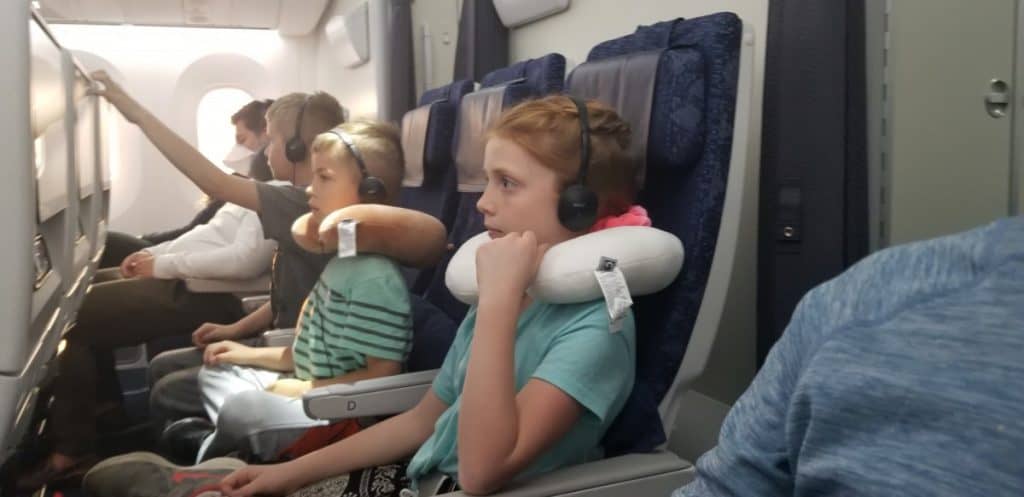 My last suggestion for ensuring sleep on the plane is to dress for it. This can just mean comfortable clothes that you can imagine sleeping in or it could mean actually changing younger kids into pajamas to signal that it’s time for rest.
My last suggestion for ensuring sleep on the plane is to dress for it. This can just mean comfortable clothes that you can imagine sleeping in or it could mean actually changing younger kids into pajamas to signal that it’s time for rest.
Unless you can afford first class tickets for your family, I highly recommend sitting in the back of the plane. You can read all about why this is my recommendation here.
6. Watch What You Consume
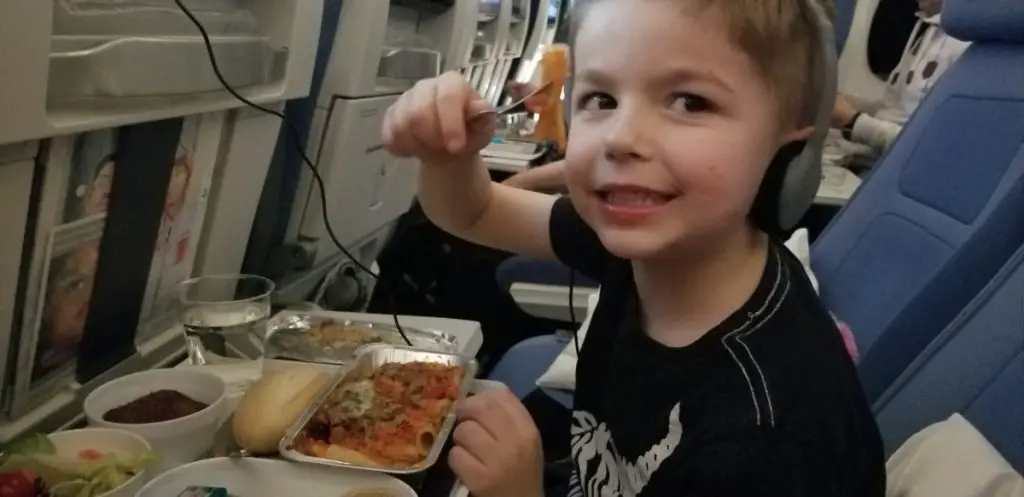 It’s VERY tempting and honestly I’ve done it, but the coffee cart and wine cart on long flights won’t necessarily be your friend. Because coffee is a sign to my body that it is morning, I think consuming it at the time frame that is the “new morning” time may help me to stay awake for awhile, but that’s not what the science tells us. Water is where it’s at since it is easier to get dehydrated at high altitudes and when we are out of our routine. Dehydration can increase symptoms. Plus, you never know when you’re going to have dump your water bottle between crossing in and out of security, etc. Drink that water while you’re sitting on the plane.
It’s VERY tempting and honestly I’ve done it, but the coffee cart and wine cart on long flights won’t necessarily be your friend. Because coffee is a sign to my body that it is morning, I think consuming it at the time frame that is the “new morning” time may help me to stay awake for awhile, but that’s not what the science tells us. Water is where it’s at since it is easier to get dehydrated at high altitudes and when we are out of our routine. Dehydration can increase symptoms. Plus, you never know when you’re going to have dump your water bottle between crossing in and out of security, etc. Drink that water while you’re sitting on the plane.
Heavy meals will make us feel sleepy which might seem helpful at the point that you want to sleep. However, earlier, I mentioned that for some people gastrointestinal symptoms can appear with jet lag so nutritious foods and light snacks in between are likely to aid in your transition.
7. Make the most of a layover/stopover
If you have the time available, consider a stop in your connecting location. A night or two in Toyko on my #2 example from Chicago to Bangkok would have allowed us to get accustomed to a similar time zone and make the first days in our destination easier. If a stopover doesn’t work for you, do a little bit of research to take advantage of services available in the airport. If you are there during daylight hours, find an airport garden or sunny corner to remind your body of the new time. Find the kids play areas and let them move around accordingly. If it’s evening, see if there are small room rental available for a nap or quiet time in an unused gate to help the kids transition.
8. Hit the Ground Running
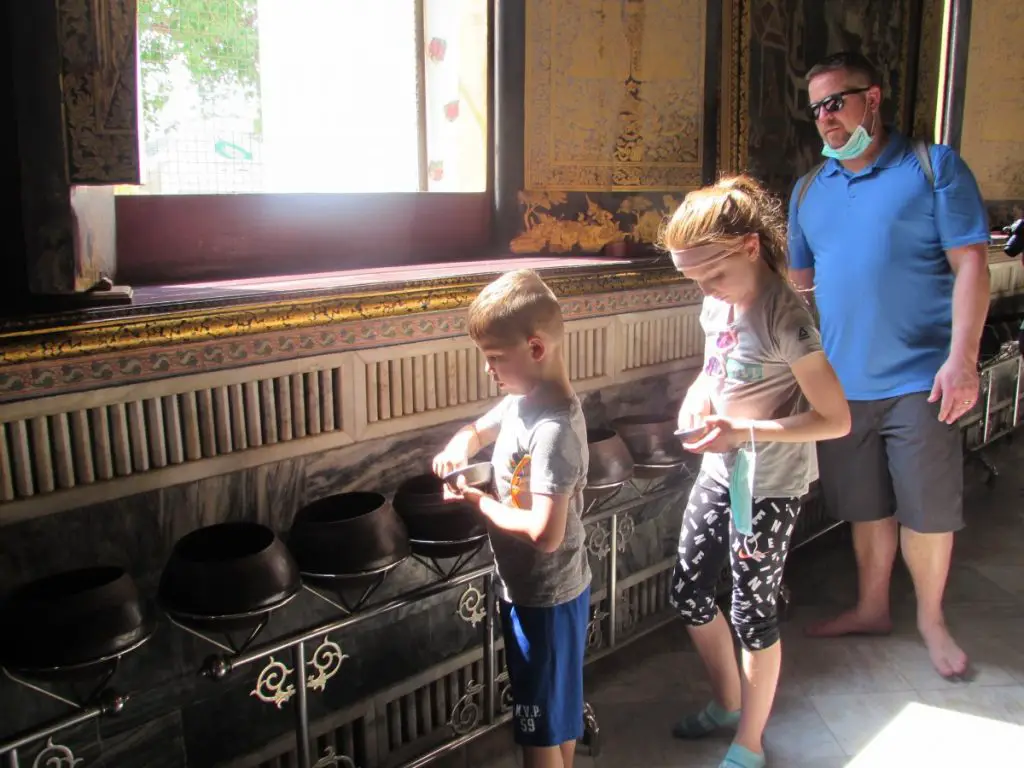 When we arrived at 5:00 AM in Bangkok after what seemed like a million hours traveling (actually about 28 hours), we knew we were up against a fight to get our bodies to push through the tired. By the time we collected our bags, took a transfer to the neighborhood in which we were staying and received our early check in, it was around 8:00 AM. We ate a small meal at the hotel breakfast buffet and met our tour guide. In advance, we had hired a private guide for a 5-6 hour introduction to Bangkok tour. We told him that we were likely going to be tired and he was happy to accommodate.
When we arrived at 5:00 AM in Bangkok after what seemed like a million hours traveling (actually about 28 hours), we knew we were up against a fight to get our bodies to push through the tired. By the time we collected our bags, took a transfer to the neighborhood in which we were staying and received our early check in, it was around 8:00 AM. We ate a small meal at the hotel breakfast buffet and met our tour guide. In advance, we had hired a private guide for a 5-6 hour introduction to Bangkok tour. We told him that we were likely going to be tired and he was happy to accommodate.
It was important that the tour was active with changing scenery from a canal boat ride to tuk tuks to touring wats to a child friendly museum to a quick lunch in one of our guide’s favorite restaurants. We made it for 5.5 hours of this planned tour before our energy was fading. The biggest challenge was the taxi ride back to the hotel where heads were bobbing. It was after 2pm by the time we reached our hotel which we filled with swimming, some downtime watching TV, and ordering room service to make it to an early evening bedtime. There is no way we could have entertained our kids without being overwhelmed by the new environment. Starting off your trip with a helpful guide to show you how public transit works and give you a base understanding of your destination really helps grow confidence and keep you awake.
9. Staying Awake – Active Rest
 For our kids, there are certain activities in which they universally be interested to participate. Swimming and going to the park are two that are typically available anywhere we go. The swimming obviously takes prioritizing this into your accommodation choice which in a big city may leave you with a rather small pool. Our kids are happy to fill part of their backpacks with their snorkel and goggles since swimming is that important to them.
For our kids, there are certain activities in which they universally be interested to participate. Swimming and going to the park are two that are typically available anywhere we go. The swimming obviously takes prioritizing this into your accommodation choice which in a big city may leave you with a rather small pool. Our kids are happy to fill part of their backpacks with their snorkel and goggles since swimming is that important to them.
 Parks too can hold this interest. Even when our kids are tired of walking, they will walk a bit more for a playground. Be sure that your park destination has a play area since in big cities a park can often just mean a green space. This can work too if there’s a place to play tag or you carry a ball to kick around. Our kids determine the quality of the park by whether there is a play set. We are about to age out of this with our big kids, but for now, we enjoy that this is a way to keep everyone refreshed.
Parks too can hold this interest. Even when our kids are tired of walking, they will walk a bit more for a playground. Be sure that your park destination has a play area since in big cities a park can often just mean a green space. This can work too if there’s a place to play tag or you carry a ball to kick around. Our kids determine the quality of the park by whether there is a play set. We are about to age out of this with our big kids, but for now, we enjoy that this is a way to keep everyone refreshed.
10. Staying Awake – Activities to Avoid
It would seem that any activity would be a good activity, but some plans can easily go awry. Any transportation that is smoothing (cars, trains) and lasts 30 minutes or more will spell naptime. Long sit down meals are common in many countries, particularly where they would like to collect your tourist dollars. Look for quick meal opportunities or meals located next to a space where kids can continue to move (i.e. piazza or square).
As opposed to the suggestion above under “Hit the Ground Running”, long tours of a less kid-oriented museum (think the Louvre or Vatican) would not be a good first day activity. I highly recommend going to these types of places with kid friendly guides, but you don’t want to get end carrying your kids for the entirety of the tour because they are bored and exhausted.
11. Staying Awake – Surprises
Save this for your last ditch effort to stay away. Make a small surprise for your child that will keep their attention for at least thirty minutes. What this item is will be dictated by your child’s interest, age, and your available space. You can check out my travel toy suggestions by age on my Travel Toy page.
12. Getting To Sleep – Comforts of Home
When trying to shift everyone’s sleep pattern, making your space as comfortable as possible is key. What does your child use for bedtime comfort at home? Lovies are important, but so are sound machines, nightlights, diffusers, and humidifiers. Whatever your family is used to using can ease the transition. We use sound machine and night light apps on our phones and ipads to reduce items to carry. There are small versions of both diffusers and humidifiers (Amazon Links). I like this humidifier because you simply attach a bottled water and you’re set.
13. Getting To Sleep – Bath Time
 According to WebMD taking the drop in body temperature after a warm bath may help to prepare your body for sleep. I would also imagine that if bathing or showering is part of your bedtime routine, this would be a great cue to your body. I think this bath tip is especially great for little ones, whether or not, they normally bath before bed. There is only so much we can will upon them, but letting their bodies prepare for sleep is our greatest ally.
According to WebMD taking the drop in body temperature after a warm bath may help to prepare your body for sleep. I would also imagine that if bathing or showering is part of your bedtime routine, this would be a great cue to your body. I think this bath tip is especially great for little ones, whether or not, they normally bath before bed. There is only so much we can will upon them, but letting their bodies prepare for sleep is our greatest ally.
14. Getting Sleep – Separate Bedrooms
No matter what your children’s ages are, having 2 separate spaces with beds/sleeping options can be a lifesaver when you’re handling jet lag. This can look like a rental with multiple bedrooms or even a extended stay type hotel room with a pullout couch in one room and a bedroom in the other. Being able to separate a child who wakes up really early in spite of your best efforts from the rest of the sleeping family is so important. If nothing else, parents can take turns getting more rest to be better able to manage the day themselves. If all else fails, the bathroom will suffice to give other family members more time to sleep.
15. To Nap or Not To Nap
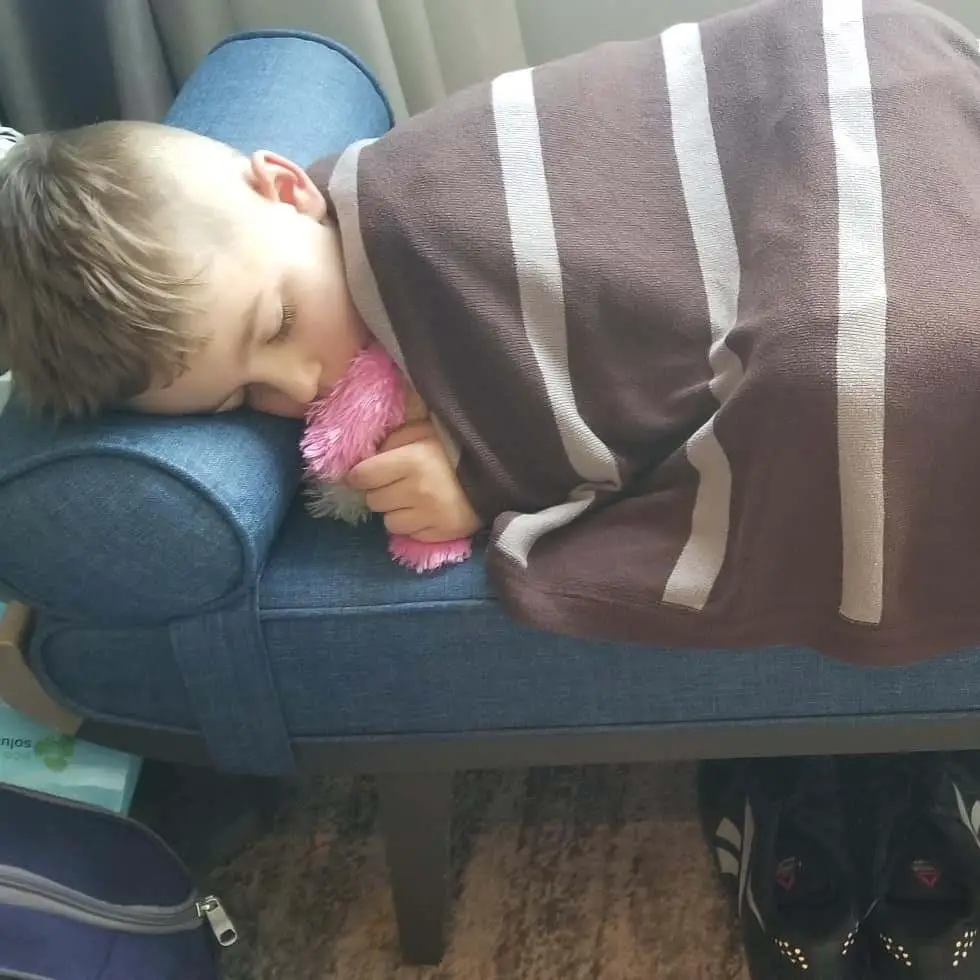 I think it’s fairly universally agreed that napping is not a help for jet lag. Some adult swear by a power nap if facing a full day without sleep, but this implies someone who understand how important it is to power through after the nap. It seems to me the main question is whether you will be able to avoid younger children taking a nap. You may not be able to stop it. Your best hope is to have a strategy to wake them up. In the situation I described about arriving in Bangkok, our six year old was dozing in the taxi returning from our morning tour and bounced back for awhile and then crashed again on a bench. We knew this was possible. We woke him up by changing his clothes, carrying him to the pool and fighting through it until he was ready to swim. It wasn’t a highlight of our trip, but we made it to the desired bedtime and were all better for compromising.
I think it’s fairly universally agreed that napping is not a help for jet lag. Some adult swear by a power nap if facing a full day without sleep, but this implies someone who understand how important it is to power through after the nap. It seems to me the main question is whether you will be able to avoid younger children taking a nap. You may not be able to stop it. Your best hope is to have a strategy to wake them up. In the situation I described about arriving in Bangkok, our six year old was dozing in the taxi returning from our morning tour and bounced back for awhile and then crashed again on a bench. We knew this was possible. We woke him up by changing his clothes, carrying him to the pool and fighting through it until he was ready to swim. It wasn’t a highlight of our trip, but we made it to the desired bedtime and were all better for compromising.
16. Sleep Aids
You will find a lot of people recommending sleep aids for flying or modifying your sleep schedule. We don’t use any, but I included this because you will also find some horror stories of parents who gave their children Benadryl and it had the opposite effect. My tip is not to try anything for the first time during travel whether it’s medication to make you drowsy or a natural supplement like Melatonin. I also don’t recommend parents take sleep aids since you never know when you children will wake up. In general, take with you only medications you have experience with and that you understand the side effects for you or your children.
17. Improving Your Chances
As parents, I think we’re always just trying to improve our chances at having a successful experience. Certainly when we have shelled out so many dollars for a once in a lifetime experience, we have more on the line than normal to make it all work. The number of hours/time zones you are traveling affects your strategy. Using the light and dark hours calculated with a jet lag calculator (above), you will want to manipulate the amount of light and dark you have access to in advance. If you need to avoid sun before dark, close up your curtains. Consider using clothes pins to block out more light. Don’t use items with artificial lights (i.e. bright screens). If you need to create more dark in the morning after you wake, wear sunglasses and use these other tips. When flipping your schedule by twelve hours, it is possible that your body will mistake dawn for dusk, yet another challenge to further travel. Just do your best to use these tricks to slowly manipulate your body’s expectation.
Once you are in your destination, be sure to set two alarms to get you moving in the morning. If kids wake up early, resist the urge to fully start the day and keep the lights down for quiet play or keep them laying down resting until you want to signal that it’s time to get up.
Just an easy reminder that our goals are mostly this:

18. How to Schedule Your Activities for the First Few Days
Now that I’ve shared that we haven’t perfected a pre-travel jet lag schedule, I wanted to share how I scheduled the first few days of the trips that are my examples.
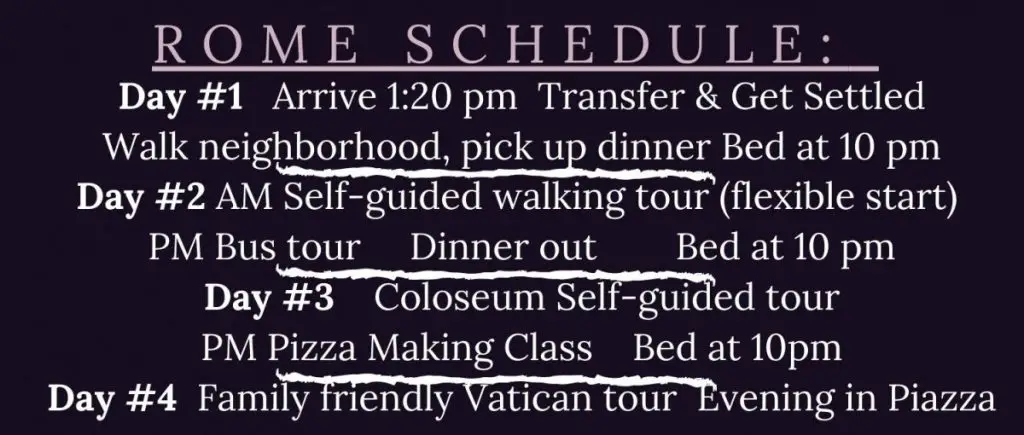
You will notice that from the beginning we were able to stretch our bedtime to normal in Rome. The jet lag wasn’t a huge issue. Yes, there were moments of tiredness and my four year old did take short naps on the go, but very similarly times to any naps he would have taken at home. I chose to ease us into this trip since I knew we only had a half day to stay away and could manage that with just the interest of our new surroundings. I also planned private and self-guided activities to allow flexibility.
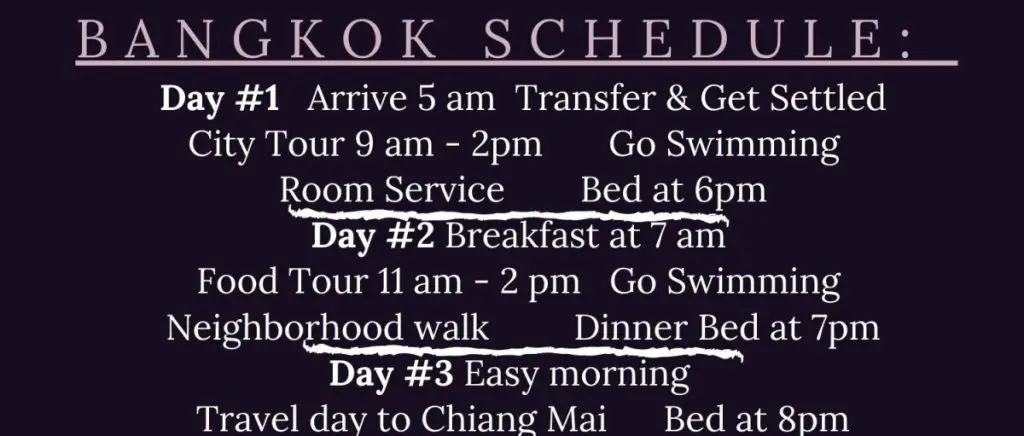 The effects of jet lag were much more noticeable on this trip and a lot of effort was made to keep adjusting. You may wonder why we would only visit Bangkok for two days when we were so initially tired. We knew it was most efficient to fly in and out of Bangkok so we decided to end our trip in Bangkok as well so we could appreciate the city more before heading home. That way if we felt too tired for something at the beginning, we had a second chance at the end.
The effects of jet lag were much more noticeable on this trip and a lot of effort was made to keep adjusting. You may wonder why we would only visit Bangkok for two days when we were so initially tired. We knew it was most efficient to fly in and out of Bangkok so we decided to end our trip in Bangkok as well so we could appreciate the city more before heading home. That way if we felt too tired for something at the beginning, we had a second chance at the end.
It’s Worth It. Enjoy!
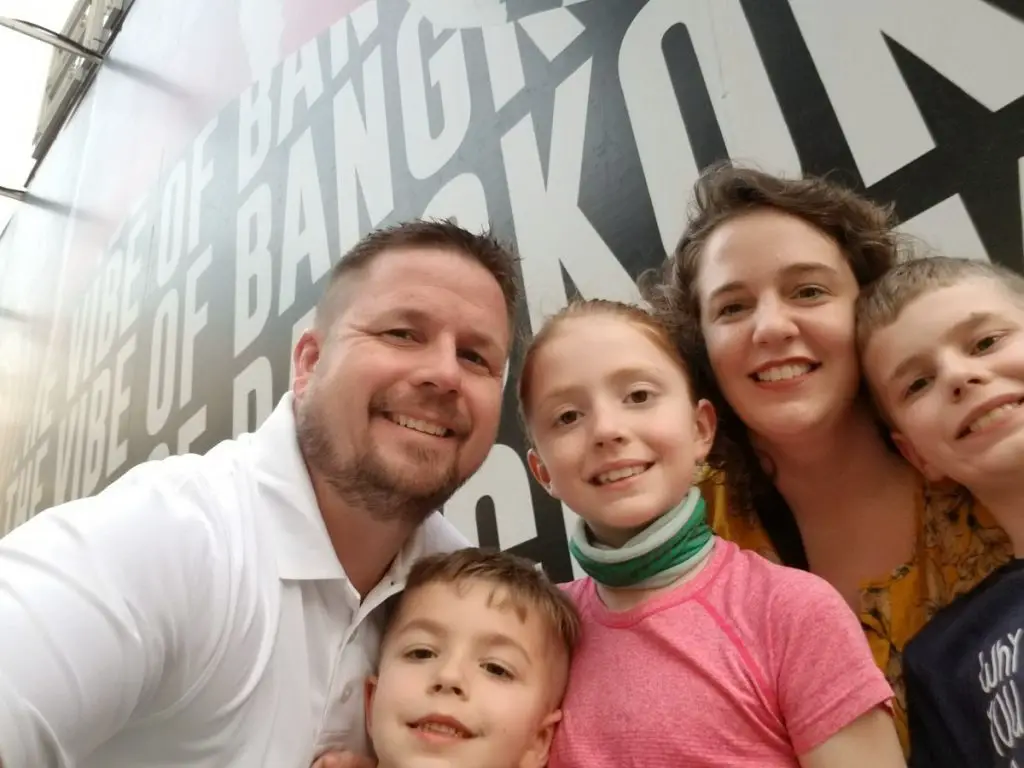 If you’re already committed to a long trip, trust that you will figure it out. Go easy on the demands you make of yourselves. Plan for flexibility with self-guided or private tours. Prepare school age kids for the reality of jet lag and how they can help themselves. If a baby or toddler is part of your current squad, plan for things to go less than perfectly and respond accordingly. I went to Hawaii with my parents before I was a toddler and although I don’t remember, I cherish the photos of me walking in the sand before I had ever walked on grass.
If you’re already committed to a long trip, trust that you will figure it out. Go easy on the demands you make of yourselves. Plan for flexibility with self-guided or private tours. Prepare school age kids for the reality of jet lag and how they can help themselves. If a baby or toddler is part of your current squad, plan for things to go less than perfectly and respond accordingly. I went to Hawaii with my parents before I was a toddler and although I don’t remember, I cherish the photos of me walking in the sand before I had ever walked on grass.
If you’re still deciding whether a long haul family trip is right for you, you won’t have to look around this site long to see that I believe it is. Travel is powerful so many beautiful ways. Enjoy the adventure!

